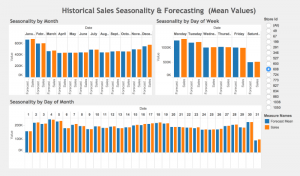2 of The Best Forecasting Methods For Your Sales Team

Why Is Sales Forecasting Important?
Sales forecasting is important for every sales team or company. It enables teams to analyse and track their performance periods of time. It also gives sales teams insight into how close they are to their monthly/quarterly targets. From there, they can plan accordingly with regards to how they might reach their objectives and goals. Sales forecasting projections enable teams to plan for the future and allow them see what what deals they are close to closing. Forecasting allows you to plan for the long-term as well as allowing you to predict the growth of your of your own success.
1. Opportunity Stage Forecasting
For every business or account your sales team is working on, each of them should have a clearly defined status. Each opportunity will be listed in your CRM as well as the stages that prospect has gone through to date. There’s nothing complex about this method and it’s also very useful to keep track of the various stages the client has gone through. The first opportunity created for example might have been the initial phone call to your client. This would have then been followed up by the a demo and then finally the negotiation period. Each stage of the of the sales forecasting will have a probability linked to it.

(Opportunity Forecast Calculation)
Pros:
- Easy To Calculate: Not everyone is a formula or maths genius, so this method is easy for everyone to understand.
- Extremely Objective: It can drive to your sales teams performance, especially when they see a potential sale sealed early. The probability of closing the sale remains low from the beginning.
Cons:
- Sometimes Inaccurate: It’s important that you fill in every single detail correctly. One wrong figure and your forecast will be inaccurate.
- Sales Cycles Aren’t Considered: For example, older opportunities are accumulated the same way as a newer opportunity would, even though they are both unlikely to be closed and sealed on the same date.
2. Historical Forecasting
With historical forecasting, it takes everything into account from your past record and how you’ve done, to then predicting how you will do in the future. Take a matching time period, look at what you sold then and assume you’ll make the same sales. This method excludes opportunities and the value associated in your pipeline. It will track back to your historical sales records and forecast your sales outcome for that date. For a company that has a steady business and are consistent month in, month out – then this would be the ideal forecasting for you!

(Source: LinkedIn)
Pros:
- Data Not As Important: If your sales reps are having trouble inputting the data then it’s not the be all and end all. Your forecasts won’t be affected if the data is inconsistent if you use this method.
Cons:
- Sales Pipeline Opportunities Not Included: If you’re team are working tenaciously, you will more than likely have a sales pipeline that is jam packed with opportunities. However, this method doesn’t take into account these opportunities.
If you’re looking to boost your sales teams performance, then we’ve got the solution! See our Social Selling online learning platform for more!
